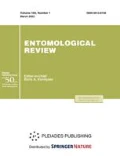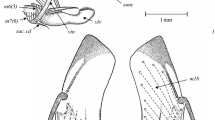Abstract
The muscles of the male genitalia were studied for the first time in representatives of 3 tribes of the Afrotropical endemic subfamily Lipteninae (Lycaenidae): Larinopoda tera (Hewitson, 1873) (Liptenini), Cephetola viridana (Joicey and Talbot, 1921) (Epitolini), Pentila tachyroides (Dewitz, 1879), P. tropicalis (Boisduval, 1847), P. umangiana Aurivillus, 1898, and Ornipholidotos amieti angulata Libert, 2005 (Pentilini). The essential differences in the genital muscles between the tribe Pentilini on the one hand and the tribes Lipteninini and Epitolini on the other are found. The tribes Liptenini and Epitolini are characterized by preservation of the characters initial for the large taxa of Papilionomorpha; the only apomorphic similarity between them, which arisen independently, is established. This apomorphy is the attachment of the only pair of aedeagus retractors m7(6) not to the zonal area of the aedeagus, as at the initial state for lepidopterans, but to its coecum penis. In the tribe Pentilini, along with the known modifications in the structure of the genital skeleton, the following apomorphic changes in muscles are established: reduction of 2 pairs of valvar muscles m5(7) and m8(3), a shift of the attachment of hypertrophied valvar adductors m4 onto a considerable part of the surface of the tegumen, and the splitting of aedeagus protractors m6(5) into 2 independent muscles. Autapomorphies of the musculoskeletal structures of Pentila Westwood, [1851] and Ornipholidotos Bethune-Baker, 1914 (Pentilini) are described. Synapomorphies in the structure of the genital muscles in the Lipteninae examined have not been found.
Similar content being viewed by others
References
De Jong, R., Vane-Wright, R.I., and Ackery, P.R., “The Higher Classification of Butterflies (Lepidoptera): Problems and Prospects,” Entomologica Scandinavica 27(1), 65–101 (1996).
Eliot, J., “The Higher Classification of the Lycaenidae: A Tentative Arrangement,” Bulletin of the British Museum (Natural History), Entomology Series 28(6), 373–505 (1973).
Eltringham, H., “XI. On the Species of the Genus Larinopoda Butler,” Transactions of the Entomological Society of London 70, 254–268 (1922).
Espeland, M., Breinholt, J., Willmott, K.R., Warren, A.D., Vila, R., Toussaint, E.F.A., Maunsell, S.C., AdusePoku, K., Talavera, G., Eastwood, R., Jarzyna, M.A., Guralnick, R., Lohman, D.J., Pierce, N.E., and Kawahara, A.Y., “A Comprehensive and Dated Phylogenomic Analysis of Butterflies,” Current Biology28(6), 770–778 (2018).
Heikkilä, M., Kaila, L., Mutanen, M., Peña, C., and Wahlberg, N., “Cretaceous Origin and Repeated Tertiary Diversification of the Redefined Butterflies,” Proceedings of the Royal Society. Biological Sciences 279, 1093–1099 (2012).
Heppner, J.B., “Tribal Classification of the Lepidoptera,” Lepidoptera News 1–2, 1–22 (2003).
Kaliszewska, Z.A., Lohman, D.J., Sommer, K., Adelson, G., Rand, D.B., Mathew, J., Talavera, G., and Pierce, N.E., “When Caterpillars Attack: Biogeography and Life History Evolution of the Miletinae (Lepidoptera: Lycaenidae),” Evolution 2015, 571–588 (2003).
Kuznetzov, VI., and Stekolnikov, A.A., New Approaches to the System of Lepidoptera of the World Fauna (Based on Abdominal Functional Morphology) (Nauka, St. Petersburg, 2001) [in Russian].
Kuznetzov, V.I., Naumann, C.M., Speidel, W., and Stekolnikov, A.A., “The Skeleton and Musculature of Male and Female Terminalia in Oenosandra boisduvalii Newman, 1856 and the Phylogenetic Position of the Family Oenosandridae (Insecta: Lepidoptera),” SHILAP Revista de Lepidopterología 32(128), 297–313 (2004).
Stekolnikov, A.A., “Evolution of the Skeleton and Musculature of the Male Genitalia in the Family Lycaenidae (Lepidoptera): II. Infratribe Polyommatina Swainson, 1827,” Entomologicheskoe Obozrenie 89(3), 561–587 (2010)
Stekolnikov, A.A., [Entomological Review 91(1), 37–57 (2011)].
Stekolnikov, A.A. and Korzeev, A.I., “The Musculoskeletal System of Male Genitalia in Curetis bulis West-wood, 1851 (Lepidoptera, Lycaenidae: Curetinae) and Paralaxita damajanti (C. Felder et R. Felder, 1860) (Lepidoptera, Riodinidae: Nemeobiinae),” Entomological Review 97(1), 1–9 (2017).
Stekolnikov, A.A. and Korzeev, A.I., “Morphology of the Male Genitalia in the Oriental Species of the Family Lycaenidae (Lepidoptera). Tribes Lycaenesthini and Polyommatini,” Entomologicheskoe Obozrenie 98(2), 339–357 [Entomologicheskoe Review 99 (3), 310–325 (2019)]. https://doi.org/10.1134/S0013873819030047
Stekolnikov, A.A. and Kuznetzov, V.I., “Evolution of Skeleton and Musculature of the Male Genitalia in the Family Lycaeni dae (Lepidoptera): I. The Cupido, Glaucopsyche, Lycaenopsis, and Itylos Sections,” Entomologicheskoe Obozrenie 84(4), 738–760 (2005)
Stekolnikov, A.A. and Kuznetzov, V.I., [Entomological Review 85(9), 1055–1073 (2005)].
Stekolnikov, A.A., Lukhtanov, V.A., and Korzeev, A.I., “Congruence between Comparative Morphology and Molecular Phylogenies: Evolution of the Male Genital Skeletal/Muscular System in the Subtribe Polyommatina (Lepidoptera, Lycaeni dae),” Entomologicheskoe Obozrenie 92(3), 517–536 (2013)
Stekolnikov, A.A., Lukhtanov, V.A., and Korzeev, A.I., [Entomological Review 94(2), 166–180 (2014)]. https://doi.org/10.1134/S0013873814020031
Stempffer, H., “The Genera of the African Lycaenidae (Lepidoptera, Rhopalocera),” Bulletin of the British Museum (National History), Entomology, Supplement 10, 3–322 (1967).
Wahlberg, N., Braby, M.F., Brower, A.V.Z., De Jong, R., Lee, M.-M., Nylin, S., Pierce, N.E., Sperling, F.A.H., Vila, R., Warren, A.D., and Zakharov, E., “Synergistic Effects of Combining Morphological and Molecular Data in Resolving the Phylogeny of Butterflies and Skippers,” Proceedings of the Royal Society, Series B 272: 1577–1586 (2005). https://doi.org/10.1098/rspb.2005.3124).
Williams, M.C., “Classification of the Afrotropical Butterflies to Generic Level,” Metamorphosis 26, 102–108 (2015).
Acknowledgments
The authors are deeply grateful to V.V. Anikin (Russia) and Szabolcs Sáfián (Hungary), who collected butterflies of the family Lycaen idae in the Kibale National Park (Uganda) for morphological studies, and also to N.Yu. Kluge (St. Petersburg) for the material collected by him on Mount Kilimanjaro.
Funding
The study was financially supported by the Russian Foundation for Basic Research (project no. 18-04-00312).
Author information
Authors and Affiliations
Corresponding authors
Additional information
Additional Information
This article was originally submitted by the authors in Russian and is first published in translation.
Rights and permissions
About this article
Cite this article
Stekolnikov, A.A., Korzeev, A.I. Male Genitalia Muscles in the Afrotropical Subfamily Lipteninae (Lepidoptera, Lycaenidae). Entmol. Rev. 99, 1239–1266 (2019). https://doi.org/10.1134/S0013873819090021
Received:
Revised:
Accepted:
Published:
Issue Date:
DOI: https://doi.org/10.1134/S0013873819090021



